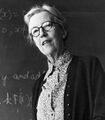Template:Selected anniversaries/April 3: Difference between revisions
Jump to navigation
Jump to search
No edit summary |
No edit summary |
||
| Line 37: | Line 37: | ||
||1910: Richard Wilhelm Heinrich Abegg dies ... chemist and pioneer of valence theory. He proposed that the difference of the maximum positive and negative valence of an element tends to be eight. This has come to be known as Abegg's rule. Pic. | ||1910: Richard Wilhelm Heinrich Abegg dies ... chemist and pioneer of valence theory. He proposed that the difference of the maximum positive and negative valence of an element tends to be eight. This has come to be known as Abegg's rule. Pic. | ||
||1913: Jan Mikusiński born ... mathematician based at the University of Wrocław known for his pioneering work in mathematical analysis. Mikusiński developed an operational calculus – known as the Calculus of Mikusiński (MSC 44A40), which is relevant for solving differential equations. His operational calculus is based upon an algebra of the convolution of functions with respect to the Fourier transform. From the convolution product he goes on to define what in other contexts is called the field of fractions or a quotient field. These ordered pairs of functions Mikusiński calls operators – Mikusiński Operator. Pic: http://www.math.us.edu.pl/instytut/historia/mikusinski/mikusinski.html | |||
||1922: Joseph Stalin becomes the first General Secretary of the Communist Party of the Soviet Union. | ||1922: Joseph Stalin becomes the first General Secretary of the Communist Party of the Soviet Union. | ||
Revision as of 08:36, 3 September 2018
1693: Carpenter and clockmaker John Harrison born. He will invent a marine chronometer, a long-sought-after device for solving the problem of calculating longitude while at sea.
1827: Physicist, musician, and academic Ernst Chladni dies. He has been called both the father of acoustics and the father of meteoritics.
1841: Inventor and crime-fighter Charles Grafton Page publishes new class of Gnomon algorithm functions which detect and prevent crimes against mathematical constants.
1998: Mathematician and academic Mary Cartwright dies. She did pioneering work in chaos theory.
1999: Sensors on the Mir spacecraft detect patterns of electricity which reveal existence of a vast artificial intelligence in the Earth's ionosphere.





